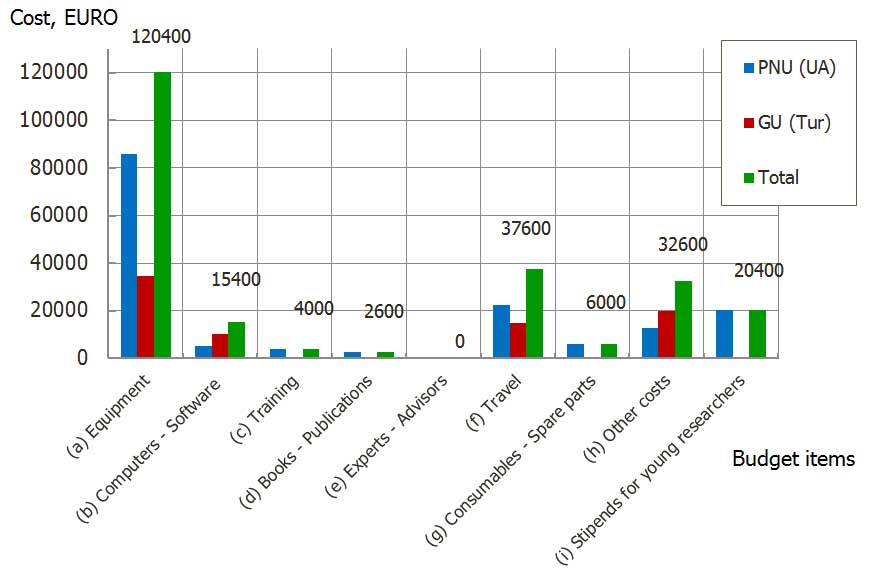
About Project
Title:
THERMOELECTRIC MATERIALS AND DEVICES FOR ENERGY SAVING AND SECURITY INCREASE
Science for Peace and Security NATO project (NUKR.SFPP 984536)
Supported by:
NATO Science for Peace and Security Program
Project Participants:
• Gazi University (Ankara, Turkey)
• Vasyl Stefanyk Precarpathian National University (Ivano-Frankivsk, Ukraine)
End-users:
• Production Company «Karpaty» (Ivano-Frankivsk, Ukraine)
• Company “TES Thermoelectric Systems Ltd.” (Ankara, Turkey)
• Institute of Innovative Research (Ivano-Frankivsk, Ukraine)
• Company «Datasystems» (Moscow, Russia)
Project Director from NATO country:
Dr., Prof. Rasit Ahiska, Gazi University; Ankara, Turkey
Project Director from NATO partner country:
PhD, Ass. Prof. Lyubomyr Nykyruy, Vasyl Stefanyk Precarpathian National University; Ivano-Frankivsk, Ukraine
Project's budget: 239,000.00 EURO
For Turkish side: 80,000.00 EURO
For Ukrainian side: 159,000.00 EURO
 Project Goals
Project Goals The project purpose is development of technology of the innovative composite thermoelectric materials on the base of IV-VI semiconductors (PbTe, SnTe) with nanoinclusions and enhanced parameters for medium temperature range (450-800) K, and creation on their basis of reliable, non-polluting thermoelectric modules for practical use as source of alternative energy, cooling units (medicine, computer servers, IR-sensors), as well as special applications (space, cathode protection, transport and military purposes).
Energy security is a critical component for national security of any country and the world at large. The energy security priorities include: reduction in specific energy consumption (energy saving), the development of alternative sources of energy, and environmental safety of energy. From above positions the project goals agree with next SPS Key priority:
1.b)- i) Innovative energy solutions for the military; renewable energy solutions with military applications;
3.a) Security-related Advanced Technology: Emerging technologies including nanotechnology.

Project Impact
Increase the share of alternative energy in the world thermoelectric is the most important problem solved by the proposed project. In particular, to expect the greater use of the conversion of thermal energy into electrical energy in the temperature range (450-800) K. Efficiency of the energy conversion is not sufficient for the large-scale transition to the thermoelectric power sources. The scientific aspect of the project involves the creation of high-performance composite materials based on nanoinclusions semiconductors PbTe and SnTe with the creation on their basis of complex multi-component compounds, making combinations of various impurities, as well as making nanoinclusions of high-melting materials, which will increase the efficiency of the existing 5-8 % to 10-15 %. Large amount of information materials to create about the advantages of thermoelectric materials for the public and producers also planned in project. Collective monograph will publish on the thermoelectric materials science, as well as the materials technology and their practical application. Successful PR-campaign will be a key point for large-scale use of thermoelectric products.
The result of the project is the creation of technical documentation for production of thermoelectric modules for mid-range temperatures. Therefore to maintain contact with the manufacturers is important. Thus, the project is aimed to end users, which are defined in the project. Other manufacturers may join to consortium at any time. Indeed, according to the marketing, in this case final production will quickly win to customers' favor in wide territorial range. Thus, the number of producers will define the competitiveness of the final product.
The project implementation will create a positive impact on the following groups: Scientific community, Government organizations, Ecological and public organizations of project’s countries-participants, Industry representatives, Commercial enterprises.
Each project’s co-director is will be in contact in their country with the special ministries to provide recommendations developed by the project participants for inclusion in the appropriate state program for the introduction of results in the field of energy management, and enhance energy security for the future transition to the new, low-cost alternative sources of the thermal energy conversion into electrical.
Upcoming events
35th Annual International Conference on Thermoelectics - ICT2016
http://www.its.org/content/35th-international-conference-thermoelectrics-ict2016
Wuhan, CHINA.
May 29th - June 02nd, 2016;
36th Annual International Conference on Thermoelectics - ICT2017
http://www.its.org/content/36th-international-conference-thermoelectrics-ict2017
Pasadena, CA, USA.
Dates are TBD (2017-01-01 shown above is merely a placeholder);
14th European Conference on Thermoelectrics (ECT2016)

Lisbon, Portugal;
September 20-23, 2016